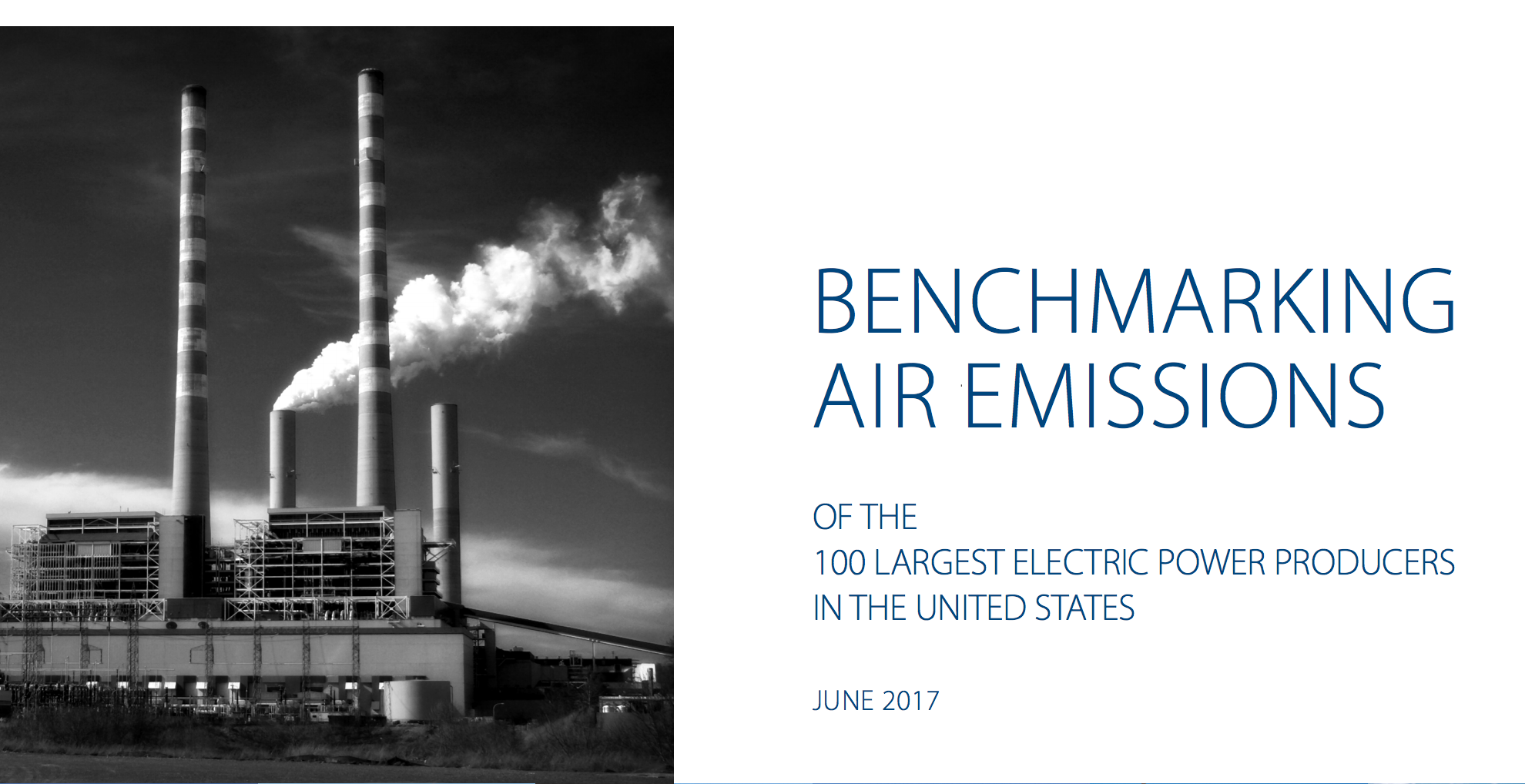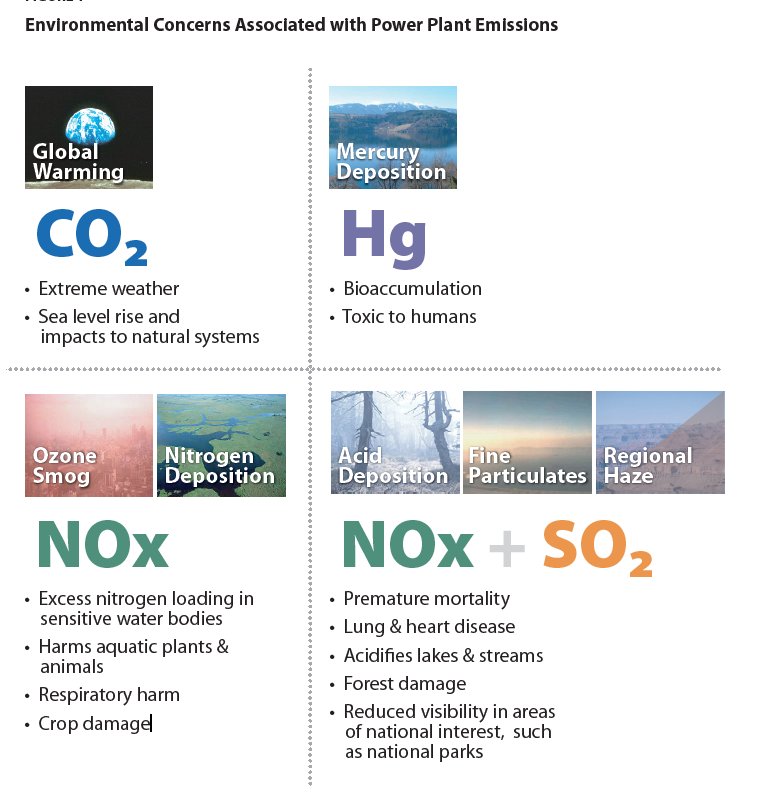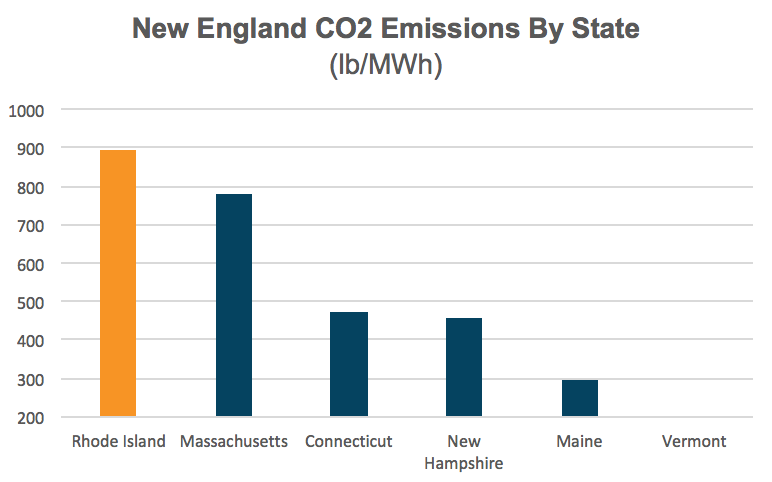 According to a new report published last month, Rhode Island already has the highest CO2 emission rate in New England. Rhode Island’s CO2 emission rate is 14% higher than the next highest New England state and a staggering 198% higher than the lowest state in New England, Vermont. The report, Benchmarking Air Emissions of the 100 Largest Electric Power Producers in the United States, was published by M.J. Bradley & Associates and was funded by a collaborative of major banks, energy companies, and the Natural Resources Defense Council. This list includes; Bank of America, Calpine, Entergy, Exelon, Tenaska, Ceres, and the Natural Resources Defense Council (NRDC). The report is based on publicly reported 2015 fuel and generation data from U.S. Energy Information Administration (EIA) and air pollutant emissions data from U.S. Environmental Protection Agency (EPA). The authors of the report benchmarked the absolute CO2 emissions as well as the “emission rate” which is a calculation dividing emissions by electricity produced for each pollutant. While Rhode Island’s 3 million tons of CO2 ranked 5th in absolute CO2 emissions (mostly a function of a low population size along with energy efficiency), it ranked 33rd overall for Co2 emission rate.
According to a new report published last month, Rhode Island already has the highest CO2 emission rate in New England. Rhode Island’s CO2 emission rate is 14% higher than the next highest New England state and a staggering 198% higher than the lowest state in New England, Vermont. The report, Benchmarking Air Emissions of the 100 Largest Electric Power Producers in the United States, was published by M.J. Bradley & Associates and was funded by a collaborative of major banks, energy companies, and the Natural Resources Defense Council. This list includes; Bank of America, Calpine, Entergy, Exelon, Tenaska, Ceres, and the Natural Resources Defense Council (NRDC). The report is based on publicly reported 2015 fuel and generation data from U.S. Energy Information Administration (EIA) and air pollutant emissions data from U.S. Environmental Protection Agency (EPA). The authors of the report benchmarked the absolute CO2 emissions as well as the “emission rate” which is a calculation dividing emissions by electricity produced for each pollutant. While Rhode Island’s 3 million tons of CO2 ranked 5th in absolute CO2 emissions (mostly a function of a low population size along with energy efficiency), it ranked 33rd overall for Co2 emission rate.
Hazardous Air Emissions
 The report focused on the following four power plant pollutants; CO2 (Carbon Dioxide), Hg (Mercury), Nox (Nitrogen Oxide), NOx + SO2 (Sulfur Dioxide). It is important to mention that the report states that these pollutants are associated with significant environmental and public health problems, including acid deposition, mercury deposition, nitrogen deposition, global warming, ground-level ozone, regional haze, and fine particle air pollution, which can trigger asthma attacks and lead to other respiratory illnesses.
The report focused on the following four power plant pollutants; CO2 (Carbon Dioxide), Hg (Mercury), Nox (Nitrogen Oxide), NOx + SO2 (Sulfur Dioxide). It is important to mention that the report states that these pollutants are associated with significant environmental and public health problems, including acid deposition, mercury deposition, nitrogen deposition, global warming, ground-level ozone, regional haze, and fine particle air pollution, which can trigger asthma attacks and lead to other respiratory illnesses.
Rhode Island’s High CO2 Emission Rate is Even Worse in Context
 It was interesting to note that while Rhode Island has the highest CO2 emissions rate in New England and was still a net energy importer, Vermont had levels that were so low they could not even be measured (the report pegged them at a low 5 lb/MWh compared to Rhode Island’s 895 lb/MWh) and yet was listed as a net energy exporter for 2015. Also interesting to note is that Rhode Island’s neighbor to the north Massachusetts has a population of 6.7 million compared to Rhode Island’s 1 million (giving them almost 7x more people) and with a GDP of $351 billion compared to Rhode Island’s $47 billion giving it an economy that dwarfs Rhode Island by $300 billion. And yet, Massachusetts still came in with significantly lower CO2 emissions rates.
It was interesting to note that while Rhode Island has the highest CO2 emissions rate in New England and was still a net energy importer, Vermont had levels that were so low they could not even be measured (the report pegged them at a low 5 lb/MWh compared to Rhode Island’s 895 lb/MWh) and yet was listed as a net energy exporter for 2015. Also interesting to note is that Rhode Island’s neighbor to the north Massachusetts has a population of 6.7 million compared to Rhode Island’s 1 million (giving them almost 7x more people) and with a GDP of $351 billion compared to Rhode Island’s $47 billion giving it an economy that dwarfs Rhode Island by $300 billion. And yet, Massachusetts still came in with significantly lower CO2 emissions rates.
No New Power Plant in Burrillville, Rhode Island!
We believe that this report sends the strongest signal yet to the citizens and leaders of our state that Rhode Island should not approve the CREC gas power plant proposed for Burrillville, Rhode Island. The report outlined that Rhode Island had 3 million tons of Co2 emissions overall in 2015. According to the CREC application submitted to the Rhode Island Energy Facility Siting Board, if approved the CREC gas and oil fueled power plant would add an additional 3.6 Million tons of CO2 emissions a year. This would be a 75% increase in our state’s CO2 emissions at time when we are trying to lower CO2 emissions. Instead of drastically increasing our CO2 emissions we should move as quickly as possible towards reasonable alternatives such as adding the 1000 MW of renewable energy by 2020 now proposed by Governor Raimondo.
Adding 1000 megawatts of clean renewable energy would:
- Help lower our CO2 emission rate
- Completely negate any perception of the need for the currently proposed gas plant
- Create thousands of good paying green energy jobs
- Provide safe and clean energy to the New England grid and help Rhode Island do our part to lower the overall CO2 emissions that are dangerously contributing to climate change
With the five major Rhode Island gas power plants included in the report data, the state of Rhode Island and our citizens (including the town Burrillville that already hosts the largest gas power plant in the state) are already contributing our fair share of Natural Gas energy generation and are already being exposed to our fair share of hazardous pollutants.
Rhode Island is at an Energy Crossroads
 According to the most recent EIA data, Rhode Island is one of the most energy-efficient states and one of the smallest consumers of energy per capita. We should continue to build on that momentum. Just as Rhode Island helped lead the way with revolution for our country’s independence, and then helped lead the way in the industrial revolution, so too we can be a part of leading the way for the clean energy revolution. Rhode Island can be a leader or a laggard. What will we do? Will we double down on the dirty and dangerous fossil fuels of the past or will we press on to the future and diversify our energy sources by focusing on renewable energy resources?
According to the most recent EIA data, Rhode Island is one of the most energy-efficient states and one of the smallest consumers of energy per capita. We should continue to build on that momentum. Just as Rhode Island helped lead the way with revolution for our country’s independence, and then helped lead the way in the industrial revolution, so too we can be a part of leading the way for the clean energy revolution. Rhode Island can be a leader or a laggard. What will we do? Will we double down on the dirty and dangerous fossil fuels of the past or will we press on to the future and diversify our energy sources by focusing on renewable energy resources?
Please spread the word, the Clear River Energy Center gas plant proposed for the woods of Burrillville, RI is not needed, not wanted, and will only serve to further lock us into decades of climate warming emissions while destroying a beautiful and important forested area of our state.

Does this report factor in the methane emissions from pipeline leaks, for which RI is infamous? Our position may be even worse.
http://www.providencejournal.com/news/20170505/danger-below-ris-gas-pipe-network-leaks-like-sieve